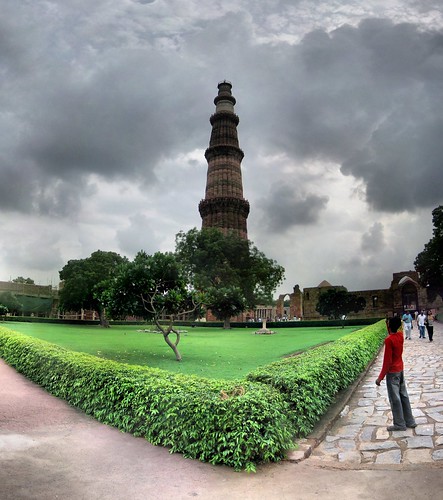The Qutab Minar (also spelled Qutb or Qutub, Urdu: قطب منار), a tower in Delhi, India, is the world's tallest brick minaret. It is situated in the Qutb complex, amidst the ruins of ancient Jain temples which were destroyed and their stones used to build the Qutb complex and minar. Construction commenced in 1193 under the orders of India's first Muslim ruler Qutb-ud-din Aibak, and the topmost storey of the minaret was completed in 1386 by Firuz Shah Tughluq. The Qutb Minar is notable for being one of the earliest and most prominent examples of Indo-Islamic architecture.
It is surrounded by several other ancient and medieval structures and ruins, collectively known as Qutb complex. The complex is listed as a UNESCO World Heritage Site and is one of the most popular tourist destinations in Delhi, and was also India's most visited monument in 2006, as it attracted 38.95 lakh visitors, even more than the Taj Mahal, which drew about 25.4 lakh visitors.
The Qutab Minar is 72.5 metres (238 ft) tall with 379 steps leading to the top. The diameter of the base is 14.3 meters wide while the top floor measures 2.75 meters in diameter. Surrounding the building are many fine examples of Indian artwork from the time it was built in 1193. A second tower was in construction and planned to be taller than the Qutb Minar itself. Its construction ended abruptly when it was about 12 meters tall.The name of this tower is given as Alau Minar and construction of recent studies shows that this structure has been tilted in one direction. It is made of red sandstone all the way except for two stories at the top. This part is of white marble and was made by Firoz Shah Tughlaq. He had decided to put a more prominent finish to the magnificent minar.
Inspired by the Minaret of Jam in Afghanistan and wishing to surpass it, Qutbuddin Aibak, the first Muslim ruler of Delhi, commenced construction of the Qutb Minar in 1193, but could only complete its base. His successor, Iltutmish, added three more stories and, in 1386, Firuz Shah Tughluq constructed the fifth and the last story. The development of architectural styles from Aibak to Tughluq are quite evident in the minaret. Like earlier towers erected by the Ghaznavids and Ghurids in Afghanistan, the Qutb Minar comprises several superposed flanged and cylindrical shafts, separated by balconies carried onMuqarnas corbels. The minaret is made of fluted red sandstone covered with intricate carvings and verses from the Qur'an. The Qutb Minar is itself built on the ruins of the Lal Kot, the Red Citadel in the city of Dhillika, the capital of the Tomars and the Chauhans, the last Hindu rulers of Delhi. The complex initially housed 27 ancient Jain temples which were destroyed and their debris used to build the Qutb minar. One engraving on the Qutb Minar reads, "Shri Vishwakarma prasade rachita" (Conceived with the grace of Vishwakarma), this is thought to have been engraved by the enslaved Hindu craftsmen who built the minar.
The purpose for building this monument has been variously speculated upon. It could take the usual role of a minaret, calling people for prayer in the Quwwat-ul-Islam mosque, the earliest extant mosque built by the Delhi Sultans. Other possibilities are a tower of victory, a monument signifying the might of Islam, or a watch tower for defense. Controversy also surrounds the origins for the name of the tower. Many historians believe that the Qutb Minar was named after the first Turkish sultan, Qutb-ud-din Aibak, but others contend that it was named in honour of Qutbuddin Bakhtiar Kaki, a saint fromTransoxiana who came to live in India and was greatly venerated by Iltutmish.
The nearby Iron Pillar is one of the world's foremost metallurgical curiosities, standing in the famous Qutb complex. According to the traditional belief, anyone who can encircle the entire column with their arms, with their back towards the pillar, can have their wish granted. Because of the corrosive qualities of sweat the government has built a fence around it for safety.


No comments:
Post a Comment